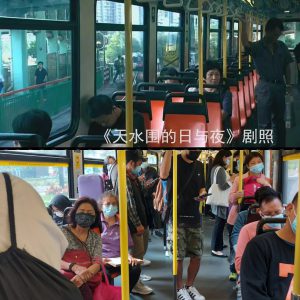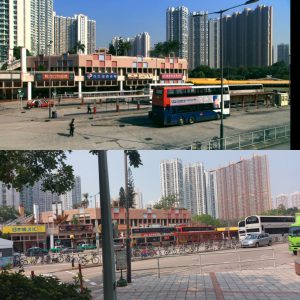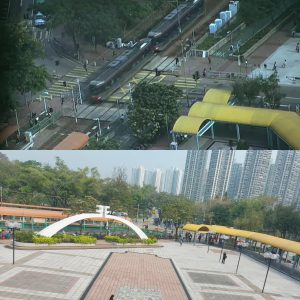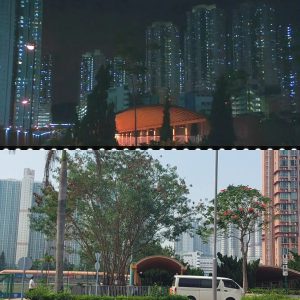THE WAY WE ARE, DIR. Ann Hui (2008)
Tin Shui Wai, Yuen Long, Hong Kong

This is Tin Yiu Estate, where the main characters live and where the film mainly based on. Comparison between real life and scenes from The Way We Are (2008), directed by Ann Hui.
The Way We Are, released on 27 March 2008, is one of Ann Hui’s most renowned films. This film is about the daily life of a single parent family, which includes the mother Gui and the son On, and their relationship with a neighbour Leung. Gui need to raise her son alone, and she is also the eldest sister in her family who had to support her brothers’ studies financially. For Leung, she is an elderly who lives alone since her daughter died in an accident. The movie starts with showing the indifferent relationship between Gui and On, and the two different lives of Gui and Leung. As the story goes on, the director depicts how the mother and son actually rely on each other and how close they are. At the same time, Gui came across with Leung, and the movie later presented the intimate relationship of the three main characters.
Features of Tin Shui Wai such as light rails, bus terminus and housing estates are well-shown in the film. The places that the film portrays are authentic to a very large extent. Tin Shui Wai is a place with a lot of immigrants and grass roots family living in. In both the film and the poster, the director showed the dense public housing buildings, which symbolize poverty. These high and dense public housing estates become a “wall”, which separates the lower-class living in Tin Shui Wai and the upper-class living in other districts. The three main characters are the representatives of people’s impressions toward the residents in Tin Shui Wai: poor and isolated. The characters live in a tiny flat from one of the public housing estates: Tin Yiu, and there are many scenes shooting the small space of the houses which again emphasize the poor background of the main characters. Although the director emphasizes much on the background of the characters, the film focuses more on the warmth between people, which can be reflected by the night scene: the lights from houses shine bright in the dark.
During the field trip, it is not easy to find that the public housing estates are densely built, which is similar to the film. The estates are very near to each other and their density is so high such that I always suddenly realized I had walked from one estate to another one. The design of buildings in different estates looks alike, furthermore, it is interesting to found that even the private housing buildings are similar to the public housing buildings.
After talking about the similarities between the space presented in film and reality, I found several obvious differences. Since the movie was filmed long time ago, many new buildings are built, while the old estates and markets are renewed. The designs of the new buildings are quite modern, which I think they do not suit the atmosphere of Tin Shui Wai. After the renewal of old buildings, with the estates and market become neater, you can still see the shadow of the original look of the building.
Lastly, I believe that the director decided to take place in Tin Shui Wai because she wants to show the sharp contrast of the impression of “The City of Sadness” with the loving care between people. The film highlighted how people helped each other in worse situations by showing the ordinary lives of the lower-classes living in Tin Shui Wai.
— Yu Yuet Chi, 3035789966


- This is the comparison between space of everyday life and space of event in the film. On the left, Gui is on her way to work; On the right, It is where Gui and Leung become a family. Comparison between real life and scenes from The Way We Are (2008), directed by Ann Hui.


On the left is Tin Shui Estate and the light rail station in Tin Shui, where the film partly based on. Things look basically the same in the film and in reality. On the right is a tunnel near Tin Sau Road. In the film, the right side of the tunnel was in construction and there were only few public housing estate, but now the construction site has become a football field, furthermore, some private housing and public housing are newly built, which makes the space denser . Comparison between real life and scenes from The Way We Are (2008), directed by Ann Hui.
Your effort in searching for the right site is appreciated. Did you feel that Tin Shui Wai is a city of sadness when you visited? Did you feel compressed by the ‘wall’ of high-rise public housing estates? It would be intriguing to compare the atmosphere between that in the film and in reality. In fact, the town has quite a lot of new public housing estates that provide better living conditions than the one chosen by Ann Hui. Do you think the director deliberately selected an older estate to emphasize the ‘City of Sadness’? Moreover, it would be nice if you could apply some concepts from the class, for instance, the ‘other’, meaning people/ spaces that are being marginalized.